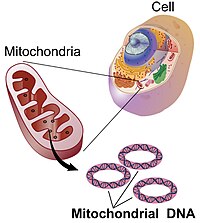
Photo from wikipedia
Background Mitochondria execute critical roles in diverse cellular pathways. As a danger signal mitochondria induce inflammation in response to stress through NLRP3 inflammasome activation, central to gout development. We recently… Click to show full abstract
Background Mitochondria execute critical roles in diverse cellular pathways. As a danger signal mitochondria induce inflammation in response to stress through NLRP3 inflammasome activation, central to gout development. We recently reported association of reduced mtDNA copy number (CN) with prevalent gout in New Zealand Māori and Pacific (Polynesian) populations1. However the cause-effect relationship is unknown. This could be evaluated by testing for association with gout using nuclear genetic variants that associate with mtDNA CN. Objectives 1) Genome wide association study (GWAS) for mtDNA CN to identify nuclear and mitochondrial loci controlling mtDNA copy number 2) test any such loci for association with gout. Methods The mtDNA CN GWAS comprised 1340 Eastern Polynesian (EP), 816 Western Polynesian (WP) and 4579 European samples (New Zealand, Germany, The Netherlands, Scotland) genotyped on the Illumina CoreExome v24 array. 343 mitochondrial single nucleotide polymorphisms (SNPs) were evaluated. As previously described2 the median of the absolute difference in X and Y probe intensities was used as a measure of mtDNA CN, and additional 10 000 randomly selected autosomal SNPs were used to calculate the principal components (PCs). A mtDNA CN GWAS was run on chromosomes 1–22 and the mitochondrial genome using Plink 1.9 .v2, adjusting for the first 10 PCs, age and sex followed by association analysis with gout adjusting by age, sex and the first 10 PCs generated from a separate set of 3000 autosomal SNPs. Results The association of reduced mtDNA CN with gout in the EP and WP groups was reproduced but there was no evidence of association of mtDNA CN with gout in Europeans. Two genome-wide significant (p<1x10–7) variants MUC17 rs78010183 (T-allele) and SLC16A8 rs75640043 (T-allele) were associated with increased mitochondrial CN in EP and WP, respectively, and mitochondrial variant rs3928306 was associated with mtDNA CN (p=4.49x10–12) in Europeans. MUC17 rs78010183 also associated with increased mtDNA CN in Europeans, with the T allele also increasing CN (β=0.06, p=1.07x10–4). The T-allele of rs78010183 was associated with gout in Europeans (OR=9.32, p=5.53x10–3) and the SLC16A8 rs75640043 T-allele was associated with gout in the WP group (OR=6.85, p=5.50x10–3). The mitochondrial variant rs3928306 A-allele (very rare in Polynesian) was not associated with gout in Europeans (OR=1.09, p=0.36). Conclusions That genetic variants associated with mitochondrial copy number also associate with gout provides evidence for a potential causal role of mitochondrial copy number in gout. However, the nuclear genetic variants support a causal relation of increased mtDNA CN with gout, conflicting with our previous observational report of association of reduced mtDNA CN with gout1. References [1] Gosling A, et al. Mitochondrial genetic variation and gout in Māori and Pacific people living in Aotearoa New Zealand. Ann Rheum Dis2017Dec 15. [Epub ahead of print]. [2] Asher FN, et al. Association of mitochondrial DNA levels with frailty and all-cause mortality. J Mol Med2015;93:177–86. Disclosure of Interest None declared
Journal Title: Annals of the Rheumatic Diseases
Year Published: 2018
Link to full text (if available)
Share on Social Media: Sign Up to like & get
recommendations!